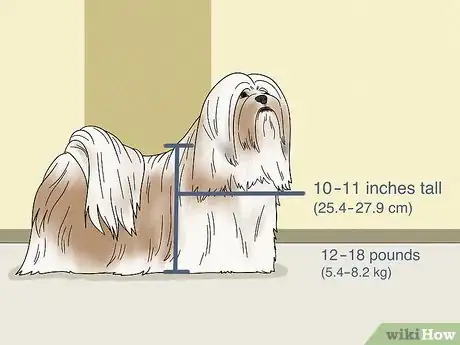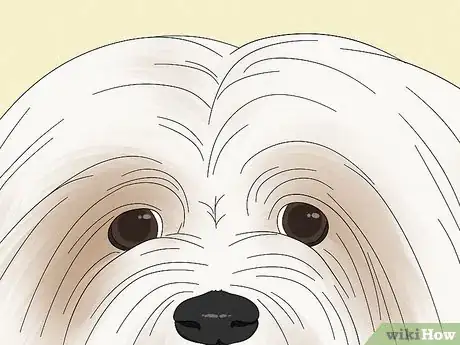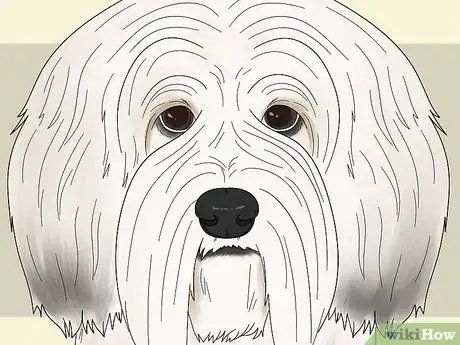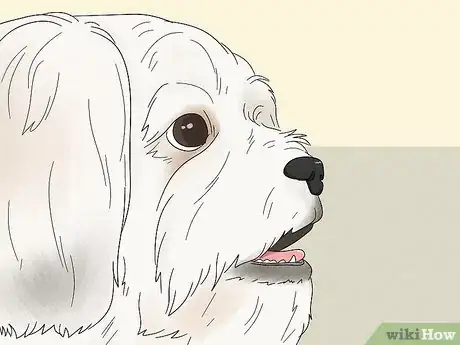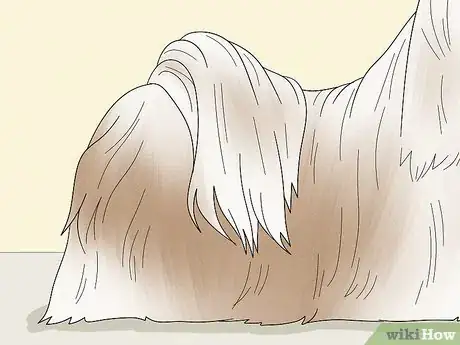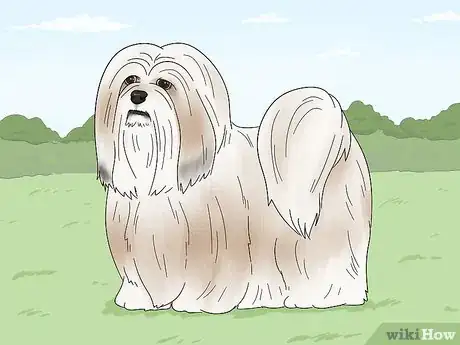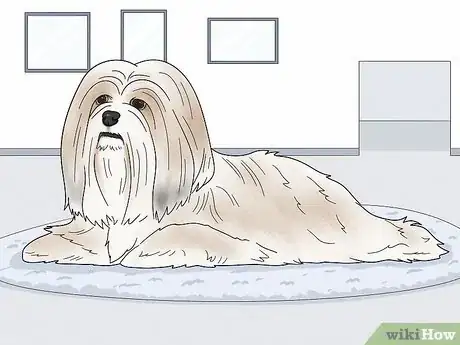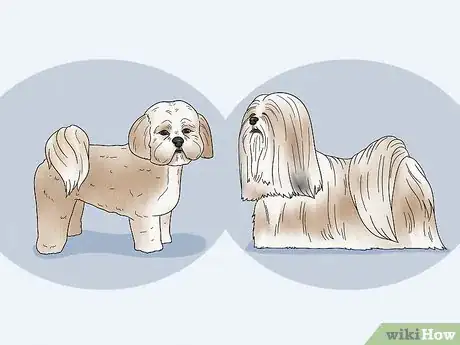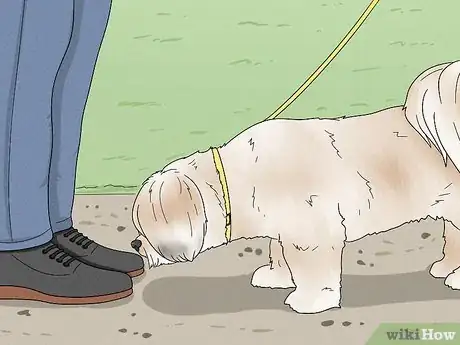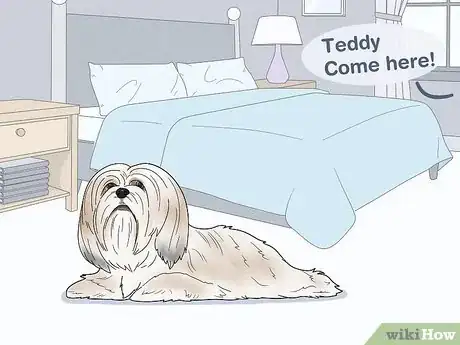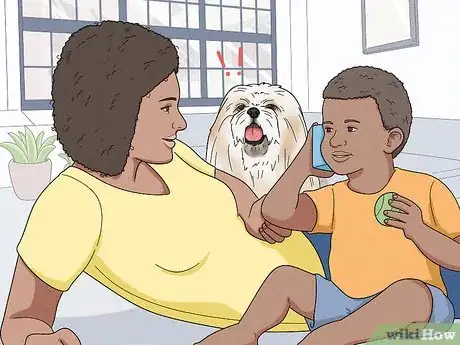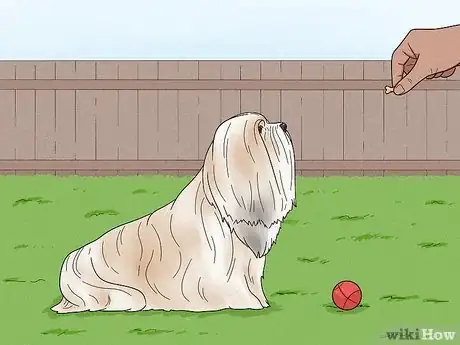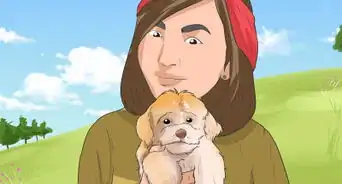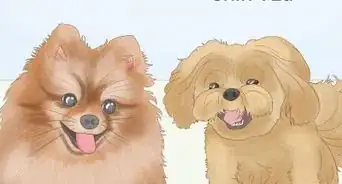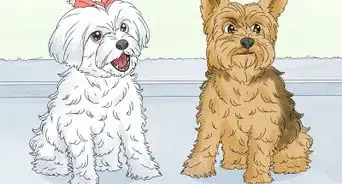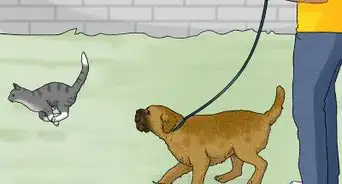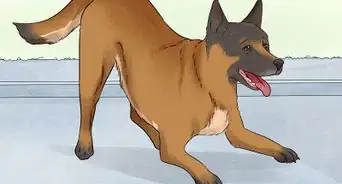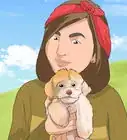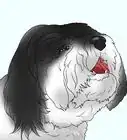wikiHow is a “wiki,” similar to Wikipedia, which means that many of our articles are co-written by multiple authors. To create this article, volunteer authors worked to edit and improve it over time.
There are 10 references cited in this article, which can be found at the bottom of the page.
This article has been viewed 42,722 times.
Learn more...
Lhasa Apsos are famed for their floor-length, flat-hanging coat which is parted in the middle and drapes over either side of their body.[1] The dog is a member of the non-sporting group, and is an ancient dog of Tibet who used to live in the Himalayan mountains.[2] The Lhasa Apso shares some traits with other dogs, but by recognising their key traits it's easy to identify a Lhasa. This wikiHow will help you know whether or not a dog is a Lhasa Apso.
Steps
Recognising the Body Structure
-
1Check the dog's size. The Lhasa Apso is a rather small breed of dog. They're only 10–11 inches (25.4–27.9 cm) tall, the females being slightly smaller, and they weigh 12–18 pounds (5.4–8.2 kg).[3]
-
2Notice the eyes. Lhasas have dark brown eyes, which are almond shaped.[4]Advertisement
-
3Find the ears. A Lhasa Apso has heavily feathered ears that are set slightly higher than eye-level. The ears are carried close to the cheek[5]
-
4Look at the muzzle. Lhasa Apsos have straight muzzles which are about one third of their head's length, from the nose to the back of the head. They have a black nose, and a level or slightly undershot bite.[6]
-
5Inspect the tail. A Lhasa has a feathery tail that's set high enough for it to be carried over the back with a curl to the side. The tail may have a kink in the end.[7]
-
6View the overall structure. A Lhasa Apso's neck is medium in length and blends smoothly into their back, and the body looks rectangular when seen in profile. The elbows are close to the body, and the legs are heavily coated in hair and straight from the elbow downward. The feet are round and catlike on both the hind legs and front.[8]
Taking Notice of the Coat
-
1
-
2Look at the coat's colour. Lhasa Apsos can be any colour, and all are equally acceptable.[11] There are some colours which are seen more frequently, despite the fact that the dog can be any colour.
-
3Look at the 'cut'. Some people choose to give their Lhasa Apsos specific haircuts, rather than leaving it the standard cut. Some of these may include: the Puppy cut, the Teddy Bear cut, the Show cut.[14]
Temperament
-
1Watch for suspicion. The Lhasa Apso can be very cautious and careful around strangers. They're very careful with their socialisation, and they may be suspicious of everyone, which can lead to biting.[18]
-
2
-
3
-
4Pay attention to intelligence. The Lhasa Apso is rather intelligent, and they have their own mind. The dog will probably do best with reward based training, because they're smart enough to learn that there are reasons to do things.[24]
-
5Check if the dog is alright being left on their own. The Lhasa Apso won't mind being left on their own, and will happily entertain themself. They're very playful, and will find something to do whenever they're inside.[25]
Community Q&A
-
QuestionHow do I know the dog's breed when it is puppy?
 LinnieTop AnswererPuppies will still have the same physical traits, such as coat color and structure. Their temperament may be somewhat different as puppies are typically more energetic and playful, so it's best to rely on physical characteristics until they're a bit older.
LinnieTop AnswererPuppies will still have the same physical traits, such as coat color and structure. Their temperament may be somewhat different as puppies are typically more energetic and playful, so it's best to rely on physical characteristics until they're a bit older. -
QuestionI have a lhasa apso and he fits all the descriptions of a purebred except the non-shedding part. Mine sheds quite a lot when his coat isn't trimmed. Why is this?
 LinnieTop AnswererSome lhasa apso do shed but just at a very slow rate, so the breed is generally considered "non-shedding" for this reason. Your dog may be an exception to this when he has a natural coat. It's completely possible that this is just natural for your dog; however, there's also a possibility that his frequent shedding is either a result of a medical condition or a mix with another breed.
LinnieTop AnswererSome lhasa apso do shed but just at a very slow rate, so the breed is generally considered "non-shedding" for this reason. Your dog may be an exception to this when he has a natural coat. It's completely possible that this is just natural for your dog; however, there's also a possibility that his frequent shedding is either a result of a medical condition or a mix with another breed.
References
- ↑ https://www.akc.org/dog-breeds/lhasa-apso/
- ↑ https://www.akc.org/expert-advice/lifestyle/8-facts-about-the-lhasa-apso/#:~:text=The%20Lhasa%20Apso%20has%20a,Buddhists%20in%20the%20Himalayan%20Mountains.&text=Lhasa%20is%20actually%20the%20capital%20of%20Tibet.
- ↑ https://www.akc.org/dog-breeds/lhasa-apso/
- ↑ https://images.akc.org/pdf/breeds/standards/LhasaApso.pdf
- ↑ https://images.akc.org/pdf/breeds/standards/LhasaApso.pdf
- ↑ https://images.akc.org/pdf/breeds/standards/LhasaApso.pdf
- ↑ https://images.akc.org/pdf/breeds/standards/LhasaApso.pdf
- ↑ https://images.akc.org/pdf/breeds/standards/LhasaApso.pdf
- ↑ https://images.akc.org/pdf/breeds/standards/LhasaApso.pdf
- ↑ https://www.akc.org/expert-advice/lifestyle/small-dogs-that-dont-shed/
- ↑ https://images.akc.org/pdf/breeds/standards/LhasaApso.pdf
- ↑ https://www.akc.org/dog-breeds/lhasa-apso/
- ↑ https://www.akc.org/dog-breeds/lhasa-apso/
- ↑ https://petcentral.chewy.com/to-shave-or-not-to-shave-your-guide-to-your-dogs-summer-do/
- ↑ https://petcentral.chewy.com/to-shave-or-not-to-shave-your-guide-to-your-dogs-summer-do/
- ↑ https://www.doggroomingcourse.com/2018/08/dog-grooming-course-sample-the-teddy-bear-cut/
- ↑ http://www.lhasa-apso.at/lhgroom.html
- ↑ https://www.yourpurebredpuppy.com/reviews/lhasaapsos.html
- ↑ https://www.dogtemperament.com/lhasa-apso-temperament/
- ↑ https://www.yourpurebredpuppy.com/reviews/lhasaapsos.html
- ↑ https://www.dogtemperament.com/lhasa-apso-temperament/
- ↑ https://www.yourpurebredpuppy.com/reviews/lhasaapsos.html
- ↑ https://bowwowinsurance.com.au/dogs/dog-breeds/lhasa-apso/
- ↑ https://www.dogtemperament.com/lhasa-apso-temperament/
- ↑ https://www.dogtemperament.com/lhasa-apso-temperament/
